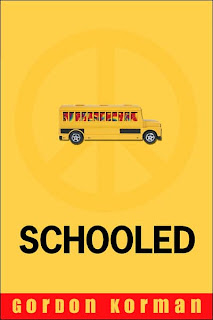Module 15
December 6 – 9

Summary:
This book is really a collection of letters by Charlie, as he writes them to an anonymous person. In his letters, Charlie recounts the events of his days in high school and the things he just doesn't understand about people. Through his letters, we learn more about Charlie's past and how he learns to actually participate in his life instead of leaning on the wall and letting it pass him by.
Citation:
Chbosky, S. (1999). The perks of being a wallflower. New York: Pocket Books.
My Impressions:
I have read other books written in letters, but none really compare to this one. I truly felt, as I read, the confusion and heartbreak that Charlie encounters as he's learning to make new friends and survive high school without his friend. I know several adults now who had the perspective of their life in high school as just getting by without being noticed. It seems to me like Charlie is okay with that, but if someone offers him something different, he'd be okay with that also. This is a very interesting coming-of-age story that will have you wondering who is he writing to and how will he survive the rest of high school.
Reviews:
From Booklist:
" Dear friend, I am writing to you because she said you listen and understand." In his letters to a never-identified person, 15-year-old Charlie's freshman high-school year (1991-92) and coming-of-age ring fresh and true. First-novelist Chbosky captures adolescent angst, confusion, and joy as Charlie reveals his innermost thoughts while trying to discover who he is and whom he is to become. Intellectually precocious, Charlie seems a tad too naive in many other ways, yet his reflections on family interactions, first date, drug experimentation, first sexual encounter, and regular participation in Rocky Horror Picture Show screenings are compelling. He vacillates between full involvement in the crazy course of his life and backing off completely. Eventually, he discovers that to be a whole person who knows how to be a real friend rather than a patsy, he must confront his past--and remember what his beloved, deceased Aunt Helen did to him. Charlie is a likable kid whose humor-laced trials and tribulations will please both adults and teens. ((Reviewed February 15, 1999)) -- Sally Estes
Estes, S. (1999 February 15). [Review of The Perks of Being a Wallflower]. Booklist.
From Publisher's Weekly:
A trite coming-of-age novel that could easily appeal to a YA readership, filmmaker Chbosky's debut broadcasts its intentions with the publisher's announcement that ads will run on MTV. Charlie, the wallflower of the title, goes through a veritable bath of bathos in his 10th grade year, 1991. The novel is formatted as a series of letters to an unnamed "friend," the first of which reveals the suicide of Charlie's pal Michael. Charlie's response--valid enough--is to cry. The crying soon gets out of hand, though--in subsequent letters, his father, his aunt, his sister and his sister's boyfriend all become lachrymose. Charlie has the usual dire adolescent problems--sex, drugs, the thuggish football team--and they perplex him in the usual teen TV ways. He hangs out with a group of seniors, among whom are Patrick and Samantha. Patrick is gay, and Charlie learns about gay. Sam is pretty, and Charlie learns about heartbreak. Sam is, alas, going out with Craig. Charlie goes out with the uppity Mary Elizabeth. Patrick goes with Brad but breaks up with him when Brad's father discovers their relationship. Into these standard teenage issues Chbosky infuses a droning insistence on Charlie's supersensitive disposition. Charlie's English teacher and others have a disconcerting tendency to rhapsodize over Charlie's giftedness, which seems to consist of Charlie's unquestioning assimilation of the teacher's taste in books. In the end we learn the root of Charlie's psychological problems, and we confront, with him, the coming rigors of 11th grade, ever hopeful that he'll find a suitable girlfriend and increase his vocabulary. (Feb.)
[Review of The Perks of Being a Wallflower]. (n.d.) Publisher's Weekly.
Library Setting Uses:
For this book, I would have teens (preferably an older group) write a letter to anonymous person about a typical day at school or write a letter anonymously about the weirdest thing they've seen at school. Have the adult running the group read aloud to the group some of the letters in order to keep anonymity, but to stimulate discussion about what really goes on at school and their perceptions of their peers.











